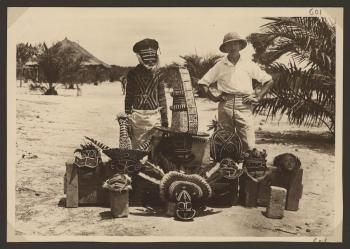Origin of the collections
The AfricaMuseum is recognised worldwide for its rich, varied and scientifically valuable collections. The majority of its visitors are unaware of the size of this heritage as the permanent exhibition only has about 1% on display.
The museum is known for its ethnographic objects, but its natural science collections, archives and photos are equally remarkable.

Where do the collections come from?
The vast majority of the objects come from the DR Congo and were collected during the colonial period.
However, the museum's collections contain specimens from around the world, dating back 650 million years (for some of the fossils) to the present day.
For example, the museum has ethnographic objects from Oceania and America as a result of exchanges between the Royal Museum for Central Africa and the Royal Museums of Art and History between 1967 and 1979.
The museum's wood collection also contains samples from around the world. It is the third largest collection in the world and the only reference collection in Belgium.
How did the collections end up in Tervuren?
When it was created in 1898, the museum encouraged military personnel, civil servants, missionaries, traders and scientists who were in the Congo to collect objects and animals.
Military campaigns
Some of the objects in the collections were gathered during military campaigns in the Congo aimed at subduing the population, defining borders and establishing the authority of the colonising power. Such objects were often weapons and other trophies acquired as spoils of war during violent clashes.
Collecting
A growing interest in the Congo led to fierce competition between European and American museums with each aiming to collect as many interesting objects as possible, preferably before the competition could take them or the colonisers remove them. Congolese artists and artisans saw this as an opportunity to make and sell objects valued by collectors.
Scientific expeditions
Since its creation, the museum has sent scientists to the Congo to collect objects and specimens. Today, the museum's scientific projects continue to add to many of the collections, such as the fish, wood and insect collections, for example.
Missionaries
The first Belgian missionaries to the Congo rejected African religious practices and destroyed objects they considered "heathen". Missionaries who had lived in the colony for some time were often more understanding and showed a greater interest in Congolese languages and cultures. The museum's conservationists would often call on them for their knowledge of the languages and their contacts with the population.
Western inhabitants in the Congo
The colonial authorities encouraged Westerners living and working in the Congo to collect objects for the museum. For some pieces, we have abundant information, whereas for others, we only know where they were discovered and the name of the collector, but not the name of the artisan or artist.
Art trade
Following the colonial exhibition of 1897, African art dealers began appearing in Brussels and Antwerp in the 19th and particularly the 20th century. Today, private collections still contain many African art objects. Some of these private collections have come to the museum following the death of their collector.
Acquisitions
The museum sometimes purchases object and collections. The museum's Acquisitions Committee carries out an integrity check and an assessment based on five criteria:
- Is the object of interest for scientific research?
- Will it round off a collection or exhibition?
- Is it of exceptional value?
- Is it well-documented?
- Does it illustrate aspects of present-day Africa?
Donations
The museum acquired many of its collections through donations. New pieces continue to be offered and added to its collections today. The Acquisitions Committee uses the same criteria for donations as it does for purchases.
Collecting today
Nowadays, objects and specimens are collected as part of field studies or research in close collaboration with universities and African museums.
The scope of research is no longer limited to Central Africa, but covers the whole of Africa south of the Sahara.
The objects and specimens are equally well documented, even though they are still only small pieces of a much larger whole.
More focus is now given to intangible cultural expressions, such as language and music, than previously.
